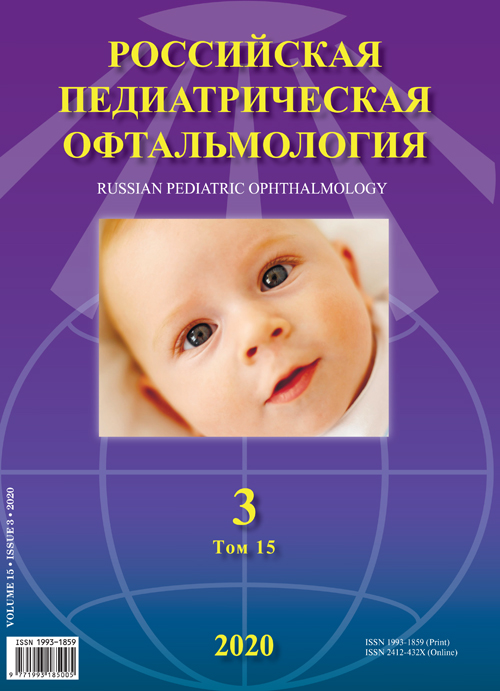Том 15, № 3 (2020)
- Год: 2020
- Выпуск опубликован: 15.09.2020
- Статей: 5
- URL: https://ruspoj.com/1993-1859/issue/view/3529
- DOI: https://doi.org/10.17816/rpoj.2020.15.3
Клинические исследования
Возможности использования двухканального метода реоофтальмографии для оценки глазного кровотока у детей и подростков с миопией
Аннотация
Цель. Изучение диагностических возможностей использования двухканального метода реоофтальмографии (РОГ) для оценки нарушений глазного кровотока у детей и подростков с миопией.
Материал и методы. В разработанном методе один из РОГ каналов имеет глубину зондирования, соответствующую локализации заднего полюса глаза, и предназначен для оценки его кровоснабжения. Второй канал позволяет оценить кровоток в артериях височной области – в зоне глазничной и внутренней сонной артерий. Оба сигнала регистрируются одновременно, что позволяет количественно оценить распределение кровотока между этими сосудистыми регионами. Для оценки диагностических возможностей метода зарегистрированы и проанализированы сигналы двухканальной реоофтальмографии 24 глаз 13 пациентов, в том числе 13 глаз 7 пациентов (средний возраст 14,1 лет) с миопией слабой степени (от -0,5 до -3,0 дптр) и 11 глаз 6 пациентов (средний возраст 23,7 лет) с эмметропией (группа контроля).
Результаты. Установлено, что для глазного отведения относительное увеличение реографического индекса (РИ) в группе пациентов с миопией слабой степени составило 4,14% при одновременном увеличении показателя РИ для височного отведения на 4,97%. Полученное аналогичным образом увеличение показателя базового импеданса (БИ) составило 22,40% для глазного отведения и 29,47% для височного отведения.
Заключение. Одновременное увеличение БИ в височной области и в области заднего полюса глаза и пропорциональное увеличение показателя пульсового кровенаполнения РИ этих областей может свидетельствовать о нарушении кровоснабжения заднего полюса глаза уже при миопии слабой степени.
 5-10
5-10


Анализ частоты развития миопии после экстракции врожденной катаракты в грудном возрасте при различных кератометрических и биометрических показателях артифакичных глаз
Аннотация
У большинства детей после экстракции врожденной катаракты (ВК) с имплантацией интраокулярных линз (ИОЛ) в грудном возрасте развивается незапланированная миопия, механизмы развития которой требуют изучения.
Цель. Изучение роли кератометрических и биометрических показателей глаз у детей с артифакией в формировании миопии.
Материал и методы. Анализ показателей рефракции, степени послеоперационного астигматизма, длины передне-задней оси (ПЗО) у 40 детей (56 глаз) с двусторонней (29 детей, 45 глаз) и односторонней (11 детей) артифакией в возрасте от 4 до 8 лет после экстракции ВК с имплантацией ИОЛ в грудном возрасте.
Результаты. В 67,9% случаев (38 глаз, 28 детей) была выявлена миопия, из них в 41,1% случаев (23 глаз, 16 детей) определялась миопия средней (12 глаз) и высокой (11 глаз) степени. Выявлена прямая связь средней силы между величиной астигматизма и степенью формирующейся миопии. При миопии средней и высокой степени чаще выявлялся астигматизм более 3,25 дптр. Для глаз с астигматизмом более 3,25 дптр длина ПЗО составила 22,6±1,9 мм (21,8-23,5 мм), в то время как при астигматизме менее 3,0 дптр длина ПЗО равнялась 20,9±1,8 мм (20,3-21,5 мм). При исходной длине ПЗО менее 20,0 мм наблюдался меньший рост глаза в послеоперационном периоде.
Заключение. У большинства детей с артифакией после экстракции врожденных катаракт в грудном возрасте развивается миопическая рефракция, на формирование которой влияет степень астигматизма и исходные значения длины ПЗО. Астигматизм более 3,0 дптр, вызывая неравномерный периферический дефокус на сетчатке, способствует чрезмерному росту глаза с артифакией после ранней хирургии ВК, что ведет к развитию осевой миопии. На глазах с ВК с исходной длиной ПЗО менее 20,0 мм риск развития миопии ниже.
 11-16
11-16


Результаты применения уф-кросслинкинга роговичного коллагена у детей и подростков при кератоконусе I-III стадии
Аннотация
Цель. Исследовать эффективность и результаты лечения кератоконуса I-III степени у детей через год после проведения кросслинкинга роговичного коллагена.
Материал и методы. Проведено стандартное офтальмологическое и углубленное кератометрическое и кератотопографическое обследование 21 глаза (15 пациентов) детей с прогрессирующим кератоконусом через 1 год после проведения им операции УФ-кросслинкинга роговичного коллагена.
Результаты. Нами выявлено статистически достоверное улучшение зрительных функций (острота зрения с коррекцией и без неё), а также стабилизация рефракционных и кератотопографических характеристик глаз с оперированным кератоконусом – уплощение центральной зоны роговицы и уменьшение площади эктазии, что проявлялось в ослаблении сильного меридиана, отсутствие прогрессирования патологического процесса в течение года после процедуры кросслинкинга.
Заключение. Применение УФ-кросслинкинга может затормозить развитие кератоконуса, улучшить оптические характеристики и прочностные свойства роговицы, стабилизировать зрительные функции и является безопасным для пациентов детского возраста, способствуя стабилизации процесса, не исключая дальнейшего динамического наблюдения за течением заболевания.
 17-22
17-22


Клинические рекомендации
Профилактика миопии в школах
Аннотация
Пособие предназначено для офтальмологов, педиатров, врачей общей практики, инструкторов-методистов по лечебной физкультуре и по гигиеническому воспитанию и содержит описание санитарных норм и физических упражнений в школах для профилактики миопии и ее прогрессирования.
 23-27
23-27


Научные обзоры
 28-36
28-36












